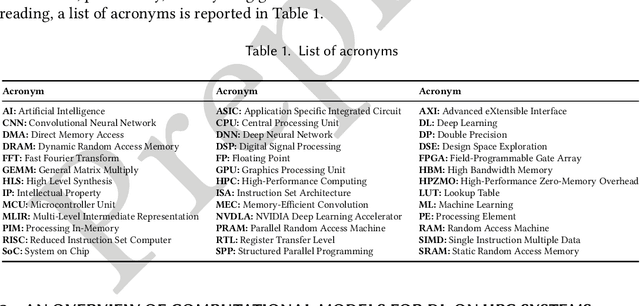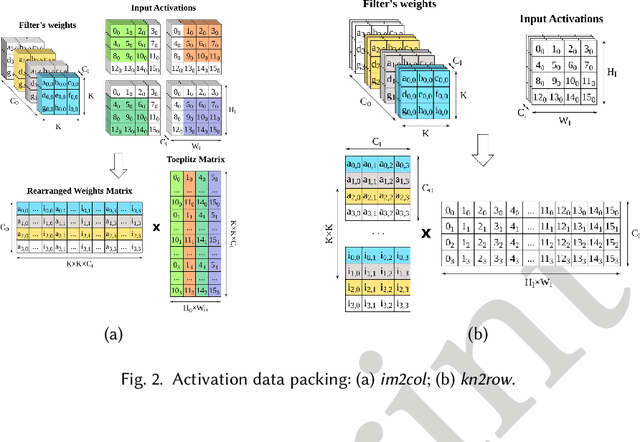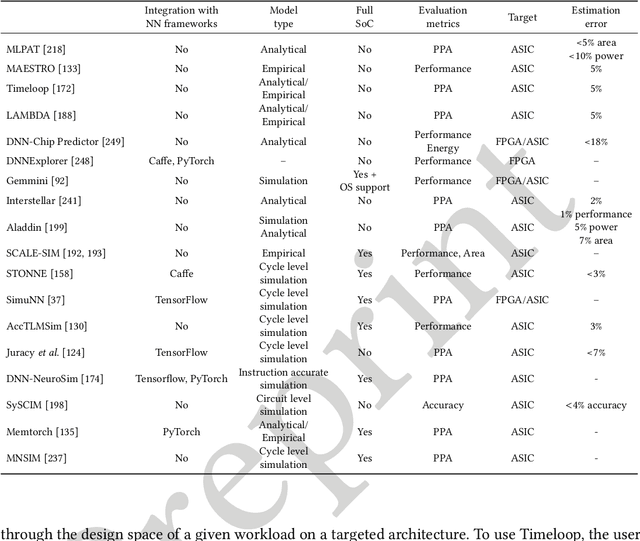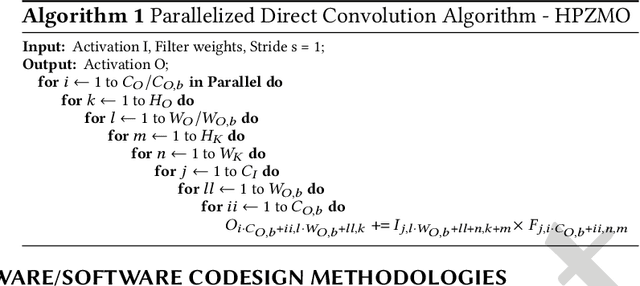Teodoro Urso
A Survey on Design Methodologies for Accelerating Deep Learning on Heterogeneous Architectures
Nov 29, 2023



Abstract:In recent years, the field of Deep Learning has seen many disruptive and impactful advancements. Given the increasing complexity of deep neural networks, the need for efficient hardware accelerators has become more and more pressing to design heterogeneous HPC platforms. The design of Deep Learning accelerators requires a multidisciplinary approach, combining expertise from several areas, spanning from computer architecture to approximate computing, computational models, and machine learning algorithms. Several methodologies and tools have been proposed to design accelerators for Deep Learning, including hardware-software co-design approaches, high-level synthesis methods, specific customized compilers, and methodologies for design space exploration, modeling, and simulation. These methodologies aim to maximize the exploitable parallelism and minimize data movement to achieve high performance and energy efficiency. This survey provides a holistic review of the most influential design methodologies and EDA tools proposed in recent years to implement Deep Learning accelerators, offering the reader a wide perspective in this rapidly evolving field. In particular, this work complements the previous survey proposed by the same authors in [203], which focuses on Deep Learning hardware accelerators for heterogeneous HPC platforms.
Design and Optimization of Residual Neural Network Accelerators for Low-Power FPGAs Using High-Level Synthesis
Sep 27, 2023Abstract:Residual neural networks are widely used in computer vision tasks. They enable the construction of deeper and more accurate models by mitigating the vanishing gradient problem. Their main innovation is the residual block which allows the output of one layer to bypass one or more intermediate layers and be added to the output of a later layer. Their complex structure and the buffering required by the residual block make them difficult to implement on resource-constrained platforms. We present a novel design flow for implementing deep learning models for field programmable gate arrays optimized for ResNets, using a strategy to reduce their buffering overhead to obtain a resource-efficient implementation of the residual layer. Our high-level synthesis (HLS)-based flow encompasses a thorough set of design principles and optimization strategies, exploiting in novel ways standard techniques such as temporal reuse and loop merging to efficiently map ResNet models, and potentially other skip connection-based NN architectures, into FPGA. The models are quantized to 8-bit integers for both weights and activations, 16-bit for biases, and 32-bit for accumulations. The experimental results are obtained on the CIFAR-10 dataset using ResNet8 and ResNet20 implemented with Xilinx FPGAs using HLS on the Ultra96-V2 and Kria KV260 boards. Compared to the state-of-the-art on the Kria KV260 board, our ResNet20 implementation achieves 2.88X speedup with 0.5% higher accuracy of 91.3%, while ResNet8 accuracy improves by 2.8% to 88.7%. The throughputs of ResNet8 and ResNet20 are 12971 FPS and 3254 FPS on the Ultra96 board, and 30153 FPS and 7601 FPS on the Kria KV26, respectively. They Pareto-dominate state-of-the-art solutions concerning accuracy, throughput, and energy.
A Survey on Deep Learning Hardware Accelerators for Heterogeneous HPC Platforms
Jun 27, 2023



Abstract:Recent trends in deep learning (DL) imposed hardware accelerators as the most viable solution for several classes of high-performance computing (HPC) applications such as image classification, computer vision, and speech recognition. This survey summarizes and classifies the most recent advances in designing DL accelerators suitable to reach the performance requirements of HPC applications. In particular, it highlights the most advanced approaches to support deep learning accelerations including not only GPU and TPU-based accelerators but also design-specific hardware accelerators such as FPGA-based and ASIC-based accelerators, Neural Processing Units, open hardware RISC-V-based accelerators and co-processors. The survey also describes accelerators based on emerging memory technologies and computing paradigms, such as 3D-stacked Processor-In-Memory, non-volatile memories (mainly, Resistive RAM and Phase Change Memories) to implement in-memory computing, Neuromorphic Processing Units, and accelerators based on Multi-Chip Modules. The survey classifies the most influential architectures and technologies proposed in the last years, with the purpose of offering the reader a comprehensive perspective in the rapidly evolving field of deep learning. Finally, it provides some insights into future challenges in DL accelerators such as quantum accelerators and photonics.
 Add to Chrome
Add to Chrome Add to Firefox
Add to Firefox Add to Edge
Add to Edge